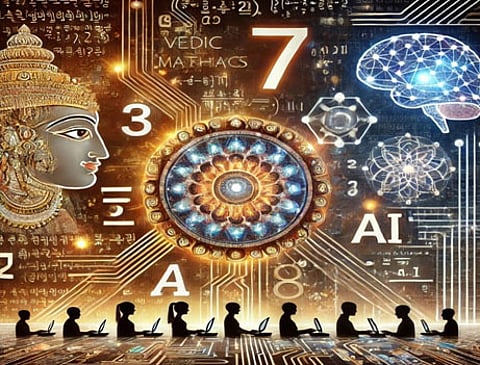
- Home
- Live Blog
- Breaking News
- Top Headlines
- Cities
- NE News
- Sentinel Media
- Sports
- Education
- Jobs

Dr Kalyanee Devi
(Assistant Professor in AI/ML and Data Science School of Natural and Applied Sciences, Pragjyotishpur University, Guwahati, Assam. She can be reached at kalyanee.devi1506@gmail.com)
In a period when artificial intelligence (AI) is revolutionising our way of thinking, living, and working, it might come as a surprise that ancient knowledge can provide answers to today’s challenges. At the forefront of technological innovation, artificial intelligence (AI) improves decision-making, streamlines procedures, and finds patterns in large datasets to propel advancements across industries. Faster and more effective computation is becoming more and more necessary as AI develops in various fields and technologies. The Vedic concept of cosmic intelligence, which holds that the universe has an innate intelligence that controls its rhythm and harmony, is consistent with AI’s capacity to replicate cognitive processes. We are forced to consider the limits of consciousness and intelligence as AI develops, drawing comparisons to the never-ending pursuit of higher consciousness in Vedic philosophy. Vedic mathematics is one old mathematical system that has the potential to transform AI calculations. Vedic mathematics, which has its roots in India’s ancient Vedic texts, provides methods for quick mental computations that may lead to new approaches to AI system optimisation. Indian science and technology, which the Indians themselves ignored, have once more returned to popular consciousness. The entire world accepts it, not just Indians. India is the home of the amazing Vedas, which include scientifically verified facts in addition to religious precepts for a perfect life.
The foundation of Vedic mathematics is a set of concise mathematical formulas called sutras. Numerous mathematical operations, including addition, subtraction, multiplication, division, square and cube roots, algebraic equations, and geometric constructions, are covered in these sutras. Every sutra is intended to speed up problem-solving and mental computation. Vedic mathematics, which is based on 13 sub-sutras and 16 sutras (aphorisms), provides remarkably straightforward solutions to challenging mathematical issues. These techniques, which include handling large numbers, squaring, fast multiplication, and division, reduce time-consuming computations into a few sophisticated steps. In order to optimise algorithms used in AI systems, scientists and engineers are now revisiting what was initially created for quick human mental math. AI requires a lot of computation. Billions of calculations must be made every second to run real-time applications or train large models, which take a significant amount of time and energy. The effectiveness of Vedic techniques may be relevant in this situation. AI algorithms have the potential to become faster, more energy-efficient, and even more sustainable by cutting down on the number of steps in calculations.
The algorithms inspired by sutras like Nikhilam Navatashcaramam Dashatah (all from 9 and the last from 10) can simplify the way machines process numbers, leading to faster data processing and reduced computational costs. The traditional use of this sutra is to simplify the subtraction and multiplication when numbers are close to the power of 10. This sutra is useful for approximation techniques in AI, thus reducing computational complexity for large datasets. This sutra turns out to be useful in designing lightweight AI models suitable for mobile devices and IoT. Another sutra, Ekadhikena Purvena, is traditionally used as a shortcut for squaring numbers ending with 5. This sutra represents incremental progress. Online learning and incremental learning models, in which algorithms are updated continuously as new data comes in, are in compliance with AI. It can serve as inspiration for adaptive AI systems, which change with their surroundings and are essential for applications like personalised recommendation systems. The Urdhva–Tiryagbhyam is a sutra that offers a methodical approach to multiplication through the use of crosswise and vertical operations. This sutra’s guidance can be used to develop algorithms that increase AI training effectiveness while speeding up and scaling calculations. The parallelism that forms the basis of GPU and TPU processing is also naturally reflected in Urdhva–Tiryagbhyam. The sutra ParavartyaYojayet is applied in solving algebraic equations by transposition. Data manipulation and transformation are essential components in modern AI. Because weight adjustments in neural networks depend on transposition and gradient flow, this sutra can serve as an inspiration for effective algorithms for data preprocessing, feature transformation, and even backpropagation.
Several areas of AI can benefit from the application of Vedic mathematical principles, which could result in faster processing times and more effective algorithms. Vedic mathematical methods could improve AI in many ways. For example, neural networks, which are the foundation of many AI systems, heavily rely on matrix multiplications. A variety of methods for speeding up and improving the efficiency of multiplication are available in Vedic mathematics. The time needed to train neural networks could be decreased, for instance, by adapting the Urdhva-Tiryakbhyam method to optimise matrix multiplications. Deep learning models could be trained on big datasets more quickly, which may result in faster convergence of learning algorithms. Also, managing the computational complexity of algorithms is one of the difficulties in developing AI, particularly as data volume grows. With their focus on elegance and simplicity, Vedic mathematical methods may provide fresh ideas for easing the computational load on AI algorithms. For instance, some computations could be made simpler and require fewer resources by using the Nikhilam Sutra’s method of dividing by complementing numbers.
The association between current artificial intelligence and ancient Vedic mathematics offers an exciting new area for innovation. The performance of AI systems can be improved by incorporating the speed, effectiveness, and problem-solving methods of Vedic techniques into AI algorithms. This is especially feasible in domains like neural networks, data processing, and complex problem-solving. Taking inspiration from Vedic mathematics could result in new discoveries that combine the knowledge of the past with the technology of the future as AI continues to shape the future.